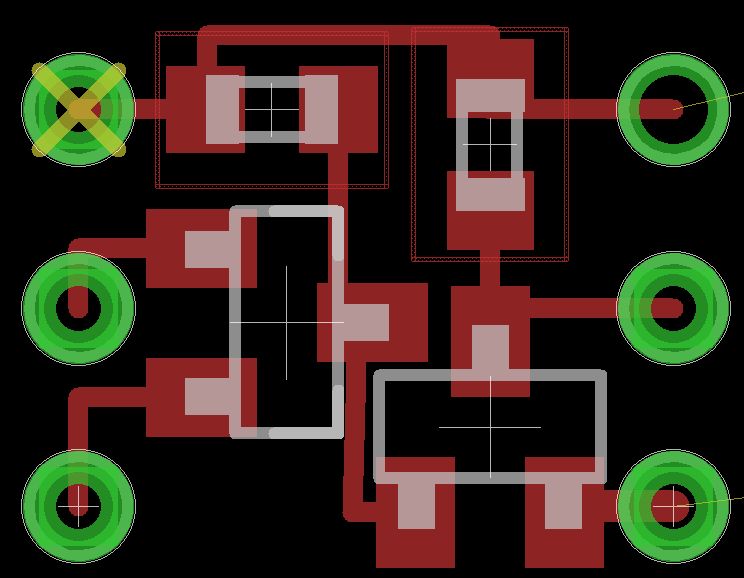I recall burning three or four weeks of a sabbatical getting Saccade.com on the air with Wordpress. So much tweaking…
Ken tinkers with DTL, and SV3ORA’s transistorized 4-bit digital computer made out of discrete DTL
Ken stumbled on one of my earlier posts about DTL (diode transistor logic) and was interested enough to do some basic exploration. He reduced the DTL NAND gate to a double diode, a transistor and two resistors. Ken sent me the LTSpice and EagleCAD screen dumps that fit in about .4″ square:
Pretty cool. In an email, Ken goes a bit further:
I’m working towards a bitslice pcb that implements either an ALU or a Program counter. Remarkably their logic is so similar that a single block of logic could be configured to match either requirement. I think I can get it all on to a 4″ x 2″ pcb with a couple of LEDs and a toggle switch on the front edge. Stack 8, 12 or 16 of these together and you have something similar to the PDP-8.
Awesome Ken! I hope to hear more about this when you have some hardware running.
I haven’t even done any real thinking since then, but I went back and tried to find some more information of people building stuff with DTL logic. I’m not sure if I spotted SV3ORA’s 4 bit digital computer before, but rereading it today, it turned out very cool. He constructed the logic on perfboard with just ordinary components. Very nice.
A transistorized 4-bit digital computer made out of discrete DTL
Addendum: Ken also pointed out the NAND to Tetris course in his email, which I believe I may have blogged about before, but which is a great resource for someone seeking to develop a more complete vertical understanding of computers from the ground up. Ken’s addition of actual soldering to the project makes it even cooler.
Comments
Comment from Ken Boak
Time 6/24/2015 at 1:44 pm
Mark,
After 1 year of absence – Have revisited DTL and successfully made a full-adder that runs at at least 1MHz. Now stretch it out to 16 bits with accompanying registers – a la PDP-8
With the advent of very cheap double-sided pcbs of 5×5 or 10×10 cm (dirtypcbs dot com) here is an opportunity to make up some really cheap pcbs with DTL bit-slices.
Watch this space
Ken
Comment from Ken Boak
Time 6/29/2015 at 11:02 am
Mark – by way of an update,
Have designed a DTL logic block (think LEGO) on a 5cm square board. Allows full-adder, clocked D-type, and various other useful building blocks.
Cost will be about $2.50.
The Hack computer featured in “The Elements of Computer Systems” or Nand to Tetris requires about 150 of these! Build your own 16-bit transistor computer for under $500.
For those not willing or able to solder 150 x 60 through hole components, there will be a pin compatible version that uses standard 74xx00 nands.
Incidently I found a great databook from 1968 which details all of the American/Anglo IC manufacturers – and all the devices they made. More than you might think for the late 1960s. Definitely a slice of history.
Here’s the link
Ken
Comment from Mark VandeWettering
Time 7/1/2015 at 3:42 pm
Hey Ken, cool! $2.50 per board == cost including boards + components? Are you making these surface mount or not? Lessee… 150 * 5cm * 5cm = 3/8 of a square meter. That’s about…15×40 inches. Yeowsa. 🙂
Comment from Ken Boak
Time 7/4/2015 at 1:52 pm
Mark
Happy Independence Day.
The 5×5 cm board size was chosen because there is a Chinese company making them for $0.66 a board.
I have looked at both conventional through-hole and surface mount. In conventional, I can get a slice of full adder, or a register slice onto the 5×5 board.
In the middle of the week I came across Dieter Mueller’s MT15 transistor computer. He used surface mount – and if you explore the backwaters of his site – he has some cool, and offbeat ideas about building ALUs. One of his ALUs would reduce the ALU slice gate count from 35 gates to 15. (That’s 320 fewer transistors, diodes and resistors to solder).
Here’s the picture page: http://www.6502.org/users/dieter/mt15/mt15.htm
Fond memories of Independence Day when I was in CA.
I was in West Oakland for 7/4/12 – and the massive irony that I was the only Brit at one Independence party gathering didn’t even register with some of my colonial chums…..
We set off a homemade cannon with black powder, (twice) then it blew out its breach – so we had to resort to some M8 fireworks, and destroyed a trash can in the middle of Peralta Street – but when the automatic gunfire started a block away, it was time to retire indoors. Then we had a big laugh when all of the San Diego city fireworks display were triggered instantaneously, and the 15 minute display was all over in 15 seconds – oops
https://www.youtube.com/watch?v=ndVhgq1yHdA
Just a normal Independence Day in West Oakland.
Comment from sv3ora
Time 4/19/2016 at 11:55 pm
Hi there,
The computer I have started designing using discrete conventional components, was fun, but I still haven’t finished it. In fact it is only 10% or so finished. The hardest part is of course the sRAM.
I do not know if I ever will have the time to finish it, but you can find it on my new site at http://www.qrp.gr
Unfortunatelly, because of the way the site is built, I do not have a direct link to post.

Comment from kiwimonster
Time 7/10/2014 at 1:57 pm
I’m reminded of the 4-bit computer I designed and put together as a college project made out of TTL components. in 1988. It was put together in a collection of solderless breadboards so it was a mass of wires that looked like a mess, but it (eventually) worked.
This effort looks cooler.